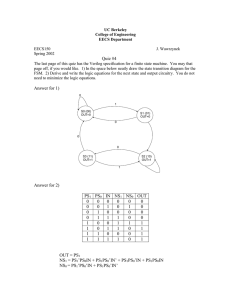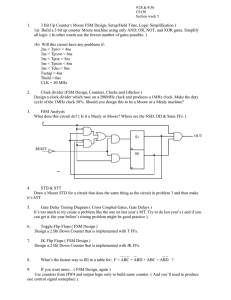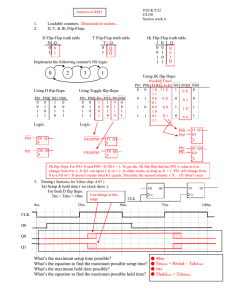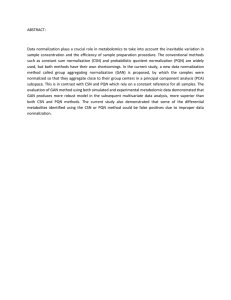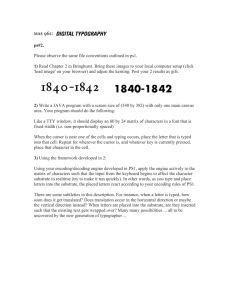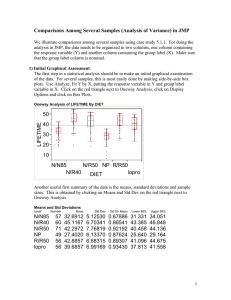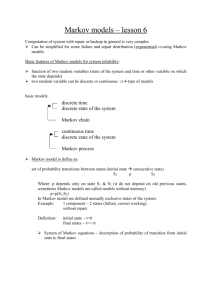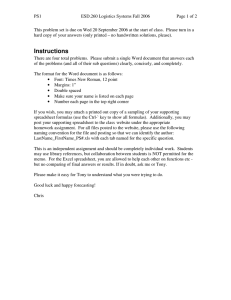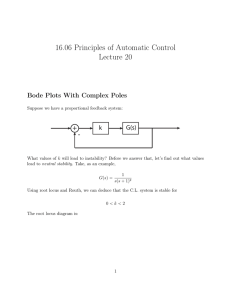Midterm 1 practice questions ( In Word!!!!! )
advertisement
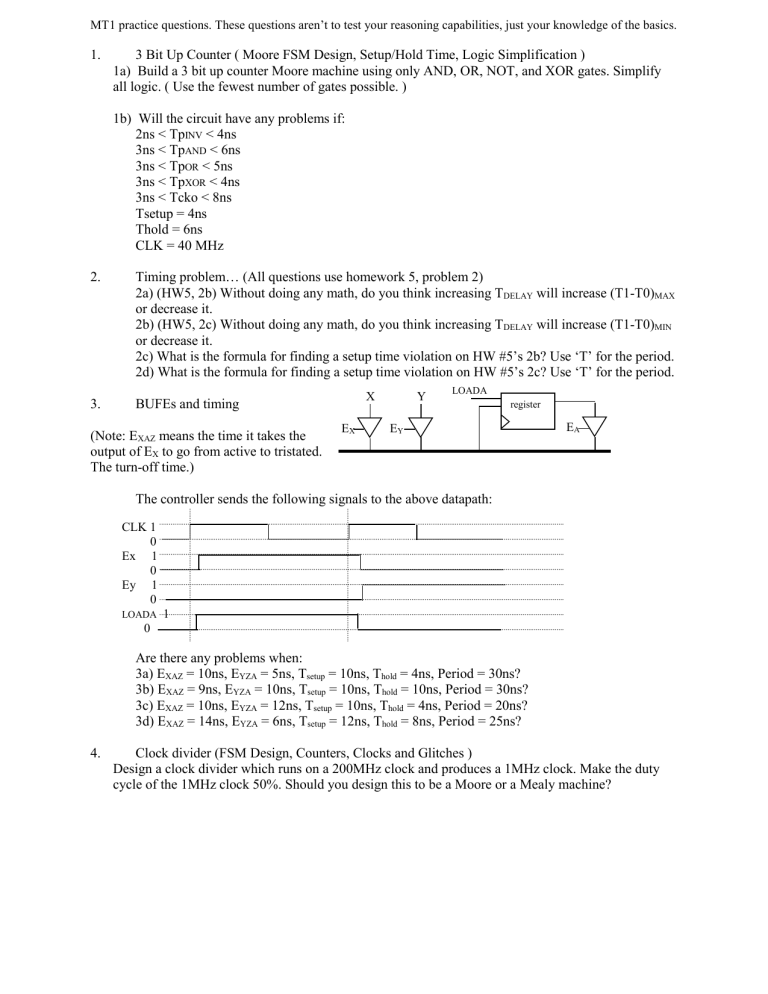
MT1 practice questions. These questions aren’t to test your reasoning capabilities, just your knowledge of the basics. 1. 3 Bit Up Counter ( Moore FSM Design, Setup/Hold Time, Logic Simplification ) 1a) Build a 3 bit up counter Moore machine using only AND, OR, NOT, and XOR gates. Simplify all logic. ( Use the fewest number of gates possible. ) 1b) Will the circuit have any problems if: 2ns < TpINV < 4ns 3ns < TpAND < 6ns 3ns < TpOR < 5ns 3ns < TpXOR < 4ns 3ns < Tcko < 8ns Tsetup = 4ns Thold = 6ns CLK = 40 MHz 2. Timing problem… (All questions use homework 5, problem 2) 2a) (HW5, 2b) Without doing any math, do you think increasing TDELAY will increase (T1-T0)MAX or decrease it. 2b) (HW5, 2c) Without doing any math, do you think increasing TDELAY will increase (T1-T0)MIN or decrease it. 2c) What is the formula for finding a setup time violation on HW #5’s 2b? Use ‘T’ for the period. 2d) What is the formula for finding a setup time violation on HW #5’s 2c? Use ‘T’ for the period. 3. BUFEs and timing (Note: EXAZ means the time it takes the output of EX to go from active to tristated. The turn-off time.) X EX Y LOADA register EY EA The controller sends the following signals to the above datapath: CLK 1 0 Ex 1 0 Ey 1 0 LOADA 1 0 Are there any problems when: 3a) EXAZ = 10ns, EYZA = 5ns, Tsetup = 10ns, Thold = 4ns, Period = 30ns? 3b) EXAZ = 9ns, EYZA = 10ns, Tsetup = 10ns, Thold = 10ns, Period = 30ns? 3c) EXAZ = 10ns, EYZA = 12ns, Tsetup = 10ns, Thold = 4ns, Period = 20ns? 3d) EXAZ = 14ns, EYZA = 6ns, Tsetup = 12ns, Thold = 8ns, Period = 25ns? 4. Clock divider (FSM Design, Counters, Clocks and Glitches ) Design a clock divider which runs on a 200MHz clock and produces a 1MHz clock. Make the duty cycle of the 1MHz clock 50%. Should you design this to be a Moore or a Mealy machine? 5. FSM Analysis What does this circuit do? ( Is it a Mealy or Moore? Where are the NSD, OD & State FFs. ) Z OUT S1 RESET S0 6. STD & STT Draw a Moore STD for a circuit that does the same thing as the circuit in problem 5 and then make it’s STT. 7. Gate Delay Timing Diagram ( Cross Coupled Gates, Gate Delays ) It’s too much to try create a problem like the one on last year’s MT. Try to do last year’s ( and if you can get it, the year before’s timing problem might be good practice ). 8. Toggle Flip Flops ( FSM Design ) Design a 2 Bit Down Counter that is implemented with T FFs. 9. JK Flip Flops ( FSM Design ) Design a 2 Bit Up Counter that is implemented with JK FFs. A 10. Use 3 BUFTs and 3 BUFEs to build a 4-1 MUX. B C D 00 01 11 S1 Also review asserted high, asserted low, & equation simplfication. OUT 10 S0 Solutions: 1. a) STT: PS2 0 0 0 0 1 1 1 1 PS1 0 0 1 1 0 0 1 1 PS0 0 1 0 1 0 1 0 1 NS2 0 0 0 1 1 1 1 0 NS1 0 1 1 0 0 1 1 0 NS0 1 0 1 0 1 0 1 0 Equations: NS0 = PS0 NS1 = PS1 PS0 NS2 = PS2 PS0 + PS2 PS1 + PS2 PS1 PS0 b) Any problems? Check for hold time violations ( Can value from flip-flop output propagate back to the flip-flop inputs so quickly that the hold time is violated? ): > Find the shortest propagation path: Looks like NS0 ( XOR gates have bigger delay than inverters ). ? Tckpmin + Tinvmin > Thold ? 3ns + 2ns > 6ns This isn’t true hold time violation possible. Check for setup time violations ( Can value from flip-flop output propagate back to the flip-flop inputs so slowly that the next clock’s setup time is violated? ) > Find the longest propagation path: Looks like NS2. ? Tckomax + Tinvmax + Tandmax + Tormax + Tsetup ?< Period ( 1/40MHz = 25ns ) 8ns + 4ns + 6ns + 5ns + 4ns < 25ns False setup time violation possible. 2. 2a) By increasing the delay, you’re delaying the change in D1’s value. Which means that you can increase T1-T0. 2b) The delay won’t affect the minimum T1-T0. 2c) Tckomax + INVTpmax + Tsumax < T – (T1-T0). 2d) Tckomax + Tdelaymax + Tsumax < T – (T1-T0). 3. 3a) Bus conflict (X & Y both on bus at same time). 3b) Hold time violation. Turn-off time (EXAZ) is less than Thold of flip-flop. 3c) Setup time violation. EYZA + Tsetup > Period. 3d) Setup time violation, hold time violation & bus conflict. 4. This should be a Moore machine with two states and no logic on the output – the output should come directly from the state bits. Because... any combinational logic, no matter how simple may cause glitches. It should change states when a counter counts up to 100. Since the output of this circuit is a clock, we have to make especially sure that there aren’t glitches on the output. Moore is safer than a Mealy in this case. Why? 5. It’s a Mealy pattern detector ( 1011 ). Equations: NS1 = R ( PS0 Z + PS1 PS0 Z ) NS0 = Z R OUT = Z PS1 PS0 RESET 0 0 0 0 0 0 0 0 1 1 1 1 1 1 1 1 STT: STD: RESET 1/0 00 0/0 1/0 01 0/0 10 11 1/0 0/0 0/0 PS1 0 0 0 0 1 1 1 1 0 0 0 0 1 1 1 1 PS0 0 0 1 1 0 0 1 1 0 0 1 1 0 0 1 1 Z 0 1 0 1 0 1 0 1 0 1 0 1 0 1 0 1 NS1 0 0 1 0 0 1 1 0 0 0 0 0 0 0 0 0 NS0 0 1 0 1 0 1 0 1 0 0 0 0 0 0 0 0 OUT 0 0 0 0 0 0 0 1 0 0 0 0 0 0 0 1 1/1 6. The Moore STD has 5 states. 1 is output in the 5th state. On the STT, make sure that the output is the same for the same PS even though the input changes. 7. ------ 8. STT: PS1 0 0 1 1 9. Equations found for T1 and T0: Bookkeeping PS0 0 1 0 1 T1 1 0 1 0 T0 1 1 1 1 NS1 1 0 0 1 NS0 1 0 1 0 STT: Bookkeeping PS1 0 0 1 1 PS0 0 1 0 1 J1K1 0X 1X X0 X1 J0K0 1X X1 1X X1 NS1 0 1 1 0 OUT1 T1 Q1 T0 Q0 OUT0 1 Equations: J1 = PS0 K1 = PS0 J0 = PS0 NS0 1 K0 = PS0 0 1 0 S0 T A X means “don’t care”. S0 T S1 E 10. A B C D B 00 01 OUT 10 S0 S1 C 11 S1 S0 S0 OUT T E D E
